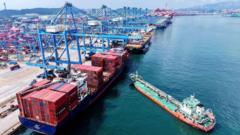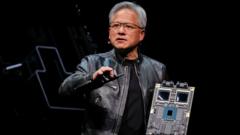In a significant shift reflecting changes in global trade dynamics, Apple has revealed plans to move the majority of iPhones produced for the US market from China to India. This transition follows concerns over tariffs imposed during the Trump administration, which has encouraged the tech giant to explore alternative manufacturing hubs. Alongside iPhones, Vietnam is set to become a primary production base for devices such as iPads and Apple Watches. While Apple's cost estimates show potential import tax impacts of up to $900 million this quarter, the company remains optimistic, citing a revenue uptick amid trade uncertainties.
Apple Shifts iPhone Production from China to India and Vietnam

Apple Shifts iPhone Production from China to India and Vietnam
Apple's CEO announces a strategic move to produce most US-bound iPhones in India, lessening reliance on China amid ongoing tariff concerns.
Apple has signaled a clear shift in its manufacturing strategy, with CEO Tim Cook stating that the company will leverage India's manufacturing capabilities for US-bound iPhones. During a recent call discussing its financial performance, Cook emphasized that the majority of iPhones sold in the US will now have India as their production location. Meanwhile, Vietnam is designated as the main production hub for various other Apple devices, including iPads, Macs, and AirPods.
This move represents a significant transition for Apple, traditionally reliant on Chinese manufacturing, and underscores ongoing trade tensions that have prompted tech firms to reassess their supply chains.
Although tariff estimates indicate that import taxes may add approximately $900 million to Apple's costs this quarter, the company's sales remain robust. Apple's first-quarter revenues for the year increased by five percent to $95.4 billion year-on-year. Notably, the company's ability to adapt to changing trade landscapes seems intact, with minimal adverse impacts on sales thus far.
Analysts highlight that while transitioning production out of China will require substantial investment and time, Cook's commitment to investing $500 billion across several US states over the next four years reflects Apple's long-term strategic planning. The uncertainties surrounding tariffs continue to pose challenges; however, executives from various tech firms, including Amazon, express optimism about navigating these turbulent waters.
As Apple begins this major manufacturing overhaul, industry experts remain cautiously optimistic, acknowledging the complexities of moving production and developing new supply chains. Yet, the early signals of resilience amid trade disruptions suggest Apple may succeed in mitigating the effects of shifting trade policies as it lays the groundwork for a diversified manufacturing strategy.
This move represents a significant transition for Apple, traditionally reliant on Chinese manufacturing, and underscores ongoing trade tensions that have prompted tech firms to reassess their supply chains.
Although tariff estimates indicate that import taxes may add approximately $900 million to Apple's costs this quarter, the company's sales remain robust. Apple's first-quarter revenues for the year increased by five percent to $95.4 billion year-on-year. Notably, the company's ability to adapt to changing trade landscapes seems intact, with minimal adverse impacts on sales thus far.
Analysts highlight that while transitioning production out of China will require substantial investment and time, Cook's commitment to investing $500 billion across several US states over the next four years reflects Apple's long-term strategic planning. The uncertainties surrounding tariffs continue to pose challenges; however, executives from various tech firms, including Amazon, express optimism about navigating these turbulent waters.
As Apple begins this major manufacturing overhaul, industry experts remain cautiously optimistic, acknowledging the complexities of moving production and developing new supply chains. Yet, the early signals of resilience amid trade disruptions suggest Apple may succeed in mitigating the effects of shifting trade policies as it lays the groundwork for a diversified manufacturing strategy.


















